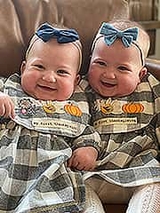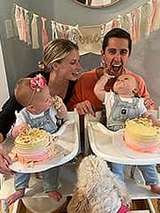Twin-twin Transfusion Syndrome: Josephine and Athena’s Story
Twin-twin Transfusion Syndrome: Josephine and Athena’s Story
A routine 20-week prenatal echocardiograph turned scary for Kate and Matt when doctors discovered a dangerous fluid imbalance between their twin girls. Follow up testing confirmed the babies had twin-to-twin transfusion syndrome. The couple was warned they could lose one or both of their babies soon and would most likely end up receiving care at Children’s Hospital of Philadelphia (CHOP).
The couple underwent additional testing with Richard C. Miller, MD, FACOG, of New Jersey Perinatal Associates, before he officially referred the family to CHOP. He’d already discussed their case with a maternal-fetal medicine specialist at the Richard D. Wood Jr. Center for Fetal Diagnosis and Treatment at CHOP, and the team at CHOP was ready to help.
Seeking expert care for twin-to-twin transfusion syndrome

The couple came to CHOP at 7 a.m. on Monday, Jan. 25, 2021. “When we got to CHOP, I felt a weight lifted off my shoulders,” Kate says. “I knew in my heart that we were in the right place and that the doctors here would save our babies.”
After a thorough prenatal examination and reviewing all imaging, the couple met with the CHOP team to discuss their daughters’ condition. It was serious; the babies were at Stage 4 TTTS, meaning that the imbalance of blood flow was causing signs of heart failure in one of the twins.
To give both babies the best chance of survival, fetoscopic laser surgery was recommended to halt the uneven blood flow between the two babies while they were still in utero. The couple agreed, and Kate was prepped for surgery.
“Within an hour, I was being wheeled into surgery,” Kate says. “CHOP was amazing – like a well-oiled machine. Everyone was on the same page. They knew their roles in my procedure, and everyone seemed to care as much as we did about giving our girls the best chance for survival.”
Laser surgery for TTTS

During the procedure, a maternal-fetal medicine specialist inserted a fetoscope, a long thin tube with a camera on the end, into the uterus to provide a detailed view of the blood vessel connections on the surface of the placenta.
Then, using sophisticated endoscopic tools and techniques, the team mapped out each blood vessel to identify the connections. Anywhere there was a connection, the laser was fired to “spot weld” the vessels shut and prevent any further blood sharing between the twins. The procedure functionally separated the single, shared placenta into two separate sections – one for each baby. Once the connecting blood vessels between the babies on the surface of the placenta were safely separated, the surgical team then removed nearly two liters of excess fluid from the amniotic cavity of the recipient twin.
Doctors said the procedure was a success, but Kate and Matt still worried. “Even after the procedure, there was still a chance I could lose the babies or go into premature labor,” Kate says. “They were still so small – Josephine was only 13 ounces and Athena was just a little more than a pound.”
Thankfully, there were no signs of early labor. And a day after surgery, a reversal of TTTS effects had already begun. Within a week, Athena’s fluid levels dropped significantly, while Josephine’s fluid levels grew – allowing her more room to move and grow. Doctors confirmed both girls had working bladders and strong heart beats.
Kate was discharged from the hospital the day after surgery and encouraged to stay nearby in case any complications arose in the week following surgery. After that, she returned home to Westfield, NJ.
The remainder of the pregnancy was relatively uneventful. Kate attended lots of doctors’ visits – returning to see the team at CHOP weekly, then bi-weekly until she was 32 weeks’ gestation; at which time her care was fully transitioned back to Dr. Miller in northern New Jersey.
Delivery of babies with TTTS and beyond

The twins were born on May 6, 2021, in a planned cesarean delivery at a nearby hospital in Livingston, NJ. Josephine weighed 5 lbs., 4 oz.; Athena was 5 lbs., 2 oz. – a role reversal from when Athena was significantly larger than her twin.
The twins went home with their parents at 4 days old – and despite some initial feeding concerns for Athena, they have done well. By three months old, both babies were thriving.
Now a little over a year old, the girls are doing great.
Athena is a “spitfire” her mother says. She and Matt jokingly play the Mission Impossible theme song while watching her play. “She’s wild, nothing holds her back,” Kate says.
Josephine is always thinking. “You can almost see the wheels moving in her head,” Kate says. “She’s more cautious when trying something new, but when she gets going, she’s quick to master whatever it is she’s putting her mind to.”
Both girls are growing well and in the healthy range for both height and weight. Developmentally, they are on par with their peers – walking, running, climbing and talking. They love to eat – especially broccoli and tangerines. And their best friend is their dog, Coconut, who is eternally patient with the active duo.
Kate and Matt don’t know what the future holds for their daughters but are committed to being the girls’ “biggest cheerleaders and encouraging them to find a way to make an impact on the world.
“Our girls are truly miracles. We’ll be forever grateful for all the doctors and nurses that took care of us during our pregnancy” Kate says. “I truly believe God put us in the right hands.”